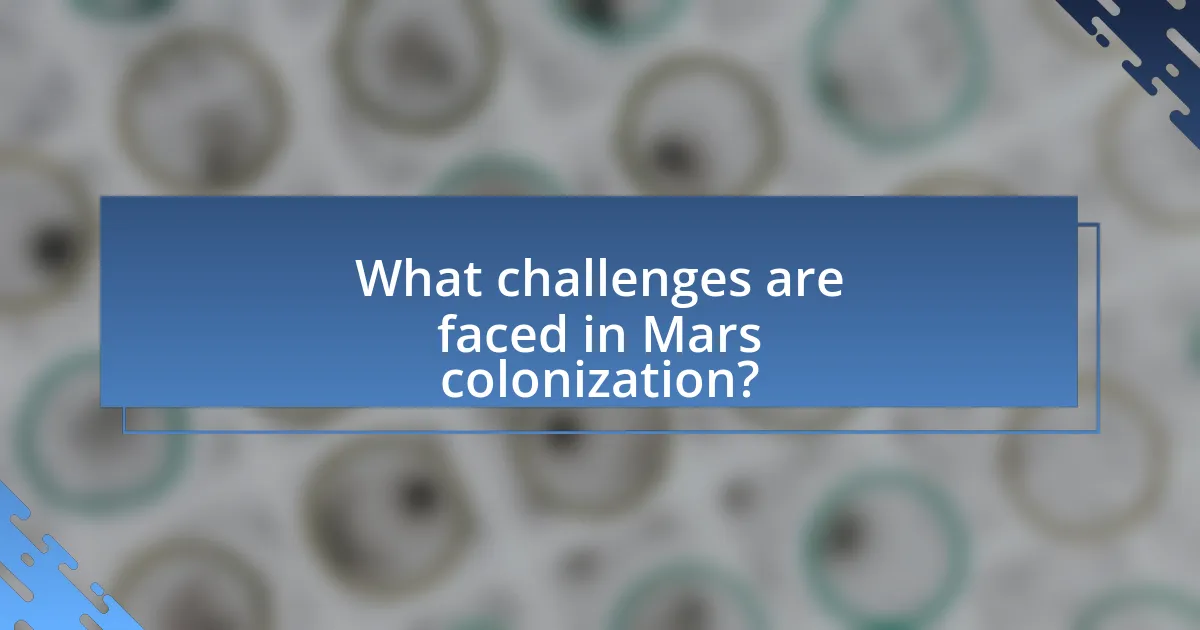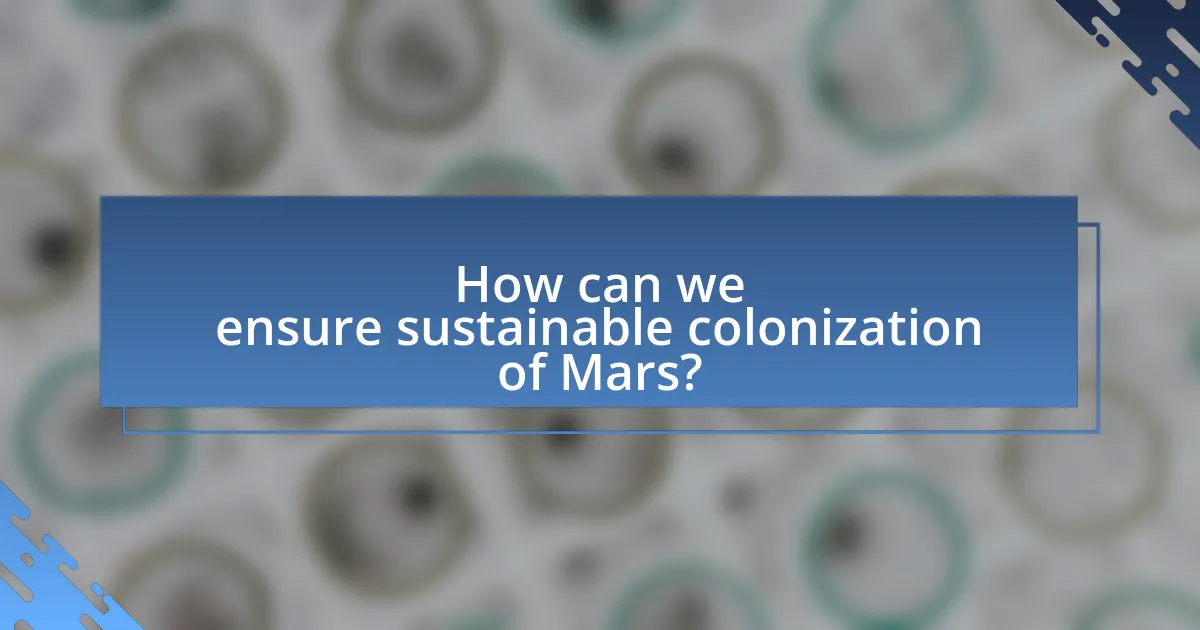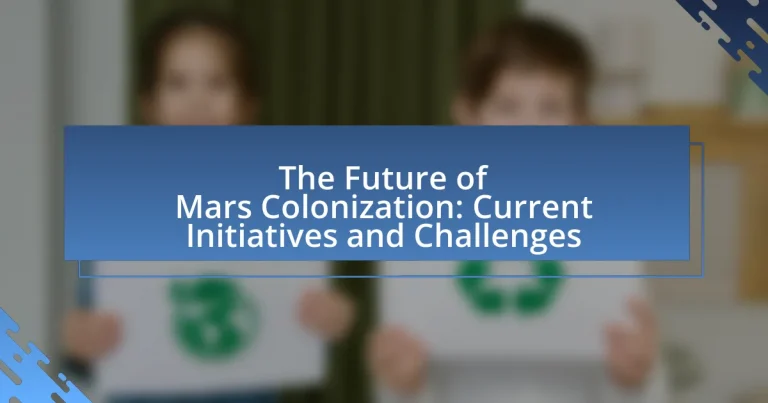The article focuses on the future of Mars colonization, detailing current initiatives and challenges associated with establishing a human presence on the planet. Key initiatives include NASA’s Artemis program, SpaceX’s Starship project, and the European Space Agency’s ExoMars program, all aimed at advancing exploration and potential settlement. The article also examines the contributions of space agencies and private companies, the technological and environmental challenges faced, and the ethical considerations surrounding colonization efforts. Additionally, it discusses practical steps for preparation, essential skills for future colonists, and strategies for sustainable resource utilization on Mars.

What are the current initiatives for Mars colonization?
Current initiatives for Mars colonization include NASA’s Artemis program, which aims to establish a sustainable human presence on the Moon as a precursor to Mars missions, and SpaceX’s Starship project, designed for interplanetary travel with the goal of sending humans to Mars by the mid-2020s. NASA’s Perseverance rover, which landed on Mars in February 2021, is also conducting experiments to assess the planet’s habitability and gather data for future human missions. Additionally, the European Space Agency is exploring potential Mars sample return missions, while private companies are developing technologies for life support and habitat construction on Mars. These initiatives are supported by significant funding and international collaboration, reflecting a growing commitment to making Mars colonization a reality.
How are space agencies contributing to Mars colonization efforts?
Space agencies are significantly contributing to Mars colonization efforts through a combination of robotic exploration, technology development, and international collaboration. NASA’s Perseverance rover, which landed on Mars in February 2021, is actively searching for signs of past life and collecting samples for future return missions, providing critical data on the planet’s habitability. The European Space Agency (ESA) is working on the ExoMars program, which aims to search for biosignatures and understand the Martian environment, further informing potential colonization strategies. Additionally, SpaceX is developing the Starship spacecraft, designed for human transport to Mars, with the goal of establishing a sustainable human presence by the 2030s. These initiatives demonstrate a concerted effort among various space agencies to advance our understanding of Mars and lay the groundwork for future human settlement.
What specific missions are planned by NASA for Mars exploration?
NASA has planned several specific missions for Mars exploration, including the Artemis program, which aims to return humans to the Moon as a stepping stone for future Mars missions, and the Mars Sample Return mission, designed to collect and return samples from the Martian surface to Earth. The Artemis program is set to launch its first crewed mission, Artemis II, in 2024, while the Mars Sample Return mission is a collaboration with the European Space Agency and is targeted for the late 2020s. These missions are part of NASA’s broader strategy to prepare for human exploration of Mars, which includes developing technologies and conducting scientific research necessary for sustainable presence on the planet.
How is the European Space Agency involved in Mars colonization?
The European Space Agency (ESA) is actively involved in Mars colonization through its Mars exploration missions and partnerships. ESA’s ExoMars program, which includes the Trace Gas Orbiter and the Rosalind Franklin rover, aims to search for signs of past life and assess the planet’s habitability, providing crucial data for future colonization efforts. Additionally, ESA collaborates with NASA on the Mars Sample Return mission, which seeks to bring Martian soil samples back to Earth, further informing human exploration and potential colonization strategies. These initiatives demonstrate ESA’s commitment to advancing our understanding of Mars and laying the groundwork for future human presence on the planet.
What role do private companies play in Mars colonization?
Private companies play a crucial role in Mars colonization by driving innovation, reducing costs, and providing essential technologies for space exploration. Companies like SpaceX are developing reusable rocket technology, which significantly lowers the cost of launching payloads to Mars. For instance, SpaceX’s Falcon 9 rocket has reduced launch costs to approximately $2,700 per kilogram, compared to traditional methods that can exceed $10,000 per kilogram. Additionally, private firms are investing in life support systems, habitat construction, and in-situ resource utilization, which are vital for sustaining human life on Mars. The collaboration between private companies and governmental space agencies, such as NASA, further accelerates research and development efforts, exemplified by NASA’s Commercial Crew Program, which partners with private entities to transport astronauts to the International Space Station and beyond.
How is SpaceX advancing the goal of Mars colonization?
SpaceX is advancing the goal of Mars colonization primarily through the development of the Starship spacecraft, designed for interplanetary travel. Starship aims to transport humans and cargo to Mars, with the capability of carrying over 100 metric tons to low Earth orbit, which is essential for establishing a sustainable presence on Mars. Additionally, SpaceX is conducting regular test flights of Starship prototypes, demonstrating its reusability and reliability, which are critical for reducing the cost of space travel. The company has also outlined plans for a Mars settlement, emphasizing the need for life support systems, in-situ resource utilization, and sustainable energy sources, all of which are vital for long-term colonization efforts.
What partnerships exist between private companies and government agencies?
Partnerships between private companies and government agencies in the context of Mars colonization include collaborations such as NASA’s Commercial Crew Program, which involves companies like SpaceX and Boeing to develop spacecraft for transporting astronauts to the International Space Station. Additionally, NASA has partnered with private firms like Blue Origin and Lockheed Martin for lunar lander development, which is a precursor to Mars missions. These partnerships leverage private sector innovation and funding to advance space exploration goals, as evidenced by NASA’s investment of over $4 billion in commercial space initiatives since 2010.

What challenges are faced in Mars colonization?
Mars colonization faces significant challenges, including harsh environmental conditions, radiation exposure, and the need for sustainable life support systems. The Martian atmosphere is composed of 95% carbon dioxide, with surface temperatures averaging around minus 80 degrees Fahrenheit, making it inhospitable for human life without advanced technology. Additionally, Mars lacks a magnetic field, exposing colonizers to harmful cosmic radiation, which increases the risk of cancer and other health issues. Furthermore, establishing a reliable supply of water, food, and oxygen is critical; current technologies for in-situ resource utilization are still in development. These factors collectively complicate the feasibility of long-term human settlement on Mars.
What are the technological challenges of colonizing Mars?
The technological challenges of colonizing Mars include life support systems, radiation protection, and sustainable energy sources. Life support systems must provide air, water, and food for long-duration missions, which requires advanced recycling technologies and agricultural methods suitable for Martian conditions. Radiation protection is critical due to Mars’ thin atmosphere and lack of a magnetic field, necessitating the development of habitats that can shield inhabitants from cosmic rays and solar radiation. Additionally, sustainable energy sources, such as solar power or nuclear energy, are essential to support human activities and infrastructure on Mars, as current technologies must be adapted to operate efficiently in the Martian environment. These challenges are supported by ongoing research and missions, such as NASA’s Perseverance rover, which aims to gather data on Martian resources and conditions to inform future colonization efforts.
How do we address life support systems for Mars habitats?
Life support systems for Mars habitats are addressed through the integration of technologies that provide essential resources such as oxygen, water, and food. These systems utilize methods like electrolysis to generate oxygen from water, which can be sourced from Martian ice, and advanced recycling systems to purify wastewater. Research indicates that closed-loop life support systems, which recycle air and water, are critical for sustaining human life on Mars, as demonstrated by experiments conducted in the Mars Society’s Mars Desert Research Station. These systems are designed to minimize resource consumption and maximize efficiency, ensuring that habitats can support human presence for extended periods.
What advancements are needed in transportation to Mars?
Advancements needed in transportation to Mars include the development of more efficient propulsion systems, enhanced life support technologies, and improved spacecraft design for long-duration missions. Efficient propulsion systems, such as nuclear thermal propulsion or ion drives, can significantly reduce travel time to Mars, which currently takes about six to nine months using conventional chemical rockets. Enhanced life support technologies are essential for sustaining human life during the journey and on the Martian surface, requiring advancements in recycling air and water, as well as food production systems. Improved spacecraft design must focus on radiation protection and habitat durability to ensure crew safety and comfort during extended missions. These advancements are critical for successful human exploration and potential colonization of Mars.
What are the environmental challenges of Mars colonization?
The environmental challenges of Mars colonization include extreme temperatures, radiation exposure, and a thin atmosphere. Mars experiences average temperatures around minus 80 degrees Fahrenheit, which poses significant risks to human survival and equipment functionality. Additionally, the planet’s atmosphere is composed of 95% carbon dioxide and lacks sufficient oxygen, making it inhospitable for human life without advanced life support systems. Furthermore, high levels of cosmic and solar radiation on Mars can lead to increased cancer risks and other health issues for colonizers, necessitating protective habitats. These factors collectively complicate the feasibility of sustainable human habitation on Mars.
How does Mars’ atmosphere affect colonization efforts?
Mars’ atmosphere significantly hinders colonization efforts due to its thinness and composition. The Martian atmosphere is about 95% carbon dioxide, with only trace amounts of oxygen, making it unsuitable for human respiration. Additionally, the atmospheric pressure on Mars is less than 1% of Earth’s, which poses challenges for maintaining liquid water and protecting colonists from harmful radiation. These factors necessitate the development of advanced life support systems and habitats that can provide breathable air and adequate protection, complicating the logistics and costs of colonization missions.
What are the implications of radiation exposure on Mars?
Radiation exposure on Mars poses significant health risks to potential colonizers, primarily due to the planet’s thin atmosphere and lack of a magnetic field, which provide minimal protection from cosmic rays and solar radiation. Studies indicate that prolonged exposure can lead to increased cancer risk, damage to the central nervous system, and acute radiation sickness. For instance, data from NASA’s Curiosity rover suggests that radiation levels on Mars are approximately 0.7 millisieverts per day, which translates to about 240 millisieverts per year, significantly higher than the annual limit of 20 millisieverts recommended for occupational exposure on Earth. This high radiation environment necessitates the development of effective shielding strategies and habitat designs to ensure the safety and health of future Mars inhabitants.

How can we ensure sustainable colonization of Mars?
To ensure sustainable colonization of Mars, we must develop closed-loop life support systems that recycle air, water, and waste. These systems are essential for long-term human habitation, as they minimize the need for resupply missions from Earth. Research indicates that technologies such as bioregenerative life support systems, which utilize plants and microorganisms to create a self-sustaining environment, can effectively support human life in space. For instance, NASA’s Veggie experiment demonstrated that crops can be grown in microgravity, providing food and oxygen while recycling carbon dioxide. Additionally, utilizing in-situ resource utilization (ISRU) to extract water and produce fuel from Martian resources will further enhance sustainability, reducing reliance on Earth-based supplies.
What strategies can be implemented for resource utilization on Mars?
Strategies for resource utilization on Mars include in-situ resource utilization (ISRU), which focuses on using local materials to support human activities. ISRU can involve extracting water from the Martian soil and atmosphere, producing oxygen from carbon dioxide, and utilizing regolith for construction materials. For instance, NASA’s Mars 2020 mission aims to demonstrate oxygen production through the MOXIE experiment, which converts carbon dioxide into oxygen, showcasing the feasibility of producing breathable air on Mars. Additionally, leveraging solar energy for power generation can support habitats and equipment, reducing reliance on Earth-supplied resources. These strategies are essential for sustainable colonization efforts, as they minimize the need for transporting resources from Earth, thereby enhancing mission viability.
How can in-situ resource utilization support long-term missions?
In-situ resource utilization (ISRU) can significantly support long-term missions by enabling the use of local resources for essential needs such as water, oxygen, and fuel. This approach reduces the dependency on Earth for supplies, thereby lowering mission costs and increasing sustainability. For example, ISRU techniques can extract water from Martian ice and convert carbon dioxide from the atmosphere into oxygen and methane, which can be used for life support and propulsion. NASA’s Mars 2020 mission aims to demonstrate these technologies, highlighting their potential to facilitate human exploration and colonization by ensuring that astronauts can live and work on Mars for extended periods without constant resupply from Earth.
What technologies are being developed for sustainable agriculture on Mars?
Technologies being developed for sustainable agriculture on Mars include hydroponics, aeroponics, and advanced soil management systems. Hydroponics allows for growing plants in nutrient-rich water without soil, which is essential in the Martian environment where soil is not conducive to traditional farming. Aeroponics, which involves growing plants in an air or mist environment, further conserves water and maximizes space. Advanced soil management systems are being researched to enhance the nutrient content of Martian regolith, making it suitable for plant growth. These technologies are crucial for supporting human life on Mars by providing a reliable food source in a sustainable manner.
What ethical considerations must be addressed in Mars colonization?
Ethical considerations in Mars colonization include planetary protection, the rights of potential extraterrestrial life, and the implications of human settlement on Mars. Planetary protection involves preventing contamination of Mars with Earth organisms, which could disrupt any existing ecosystems and violate the principle of preserving extraterrestrial environments. The rights of potential extraterrestrial life must be considered, as any discovery of microbial life would necessitate ethical frameworks to protect these organisms from exploitation or harm. Additionally, the implications of human settlement raise concerns about resource allocation, governance, and the potential for colonialism, echoing historical injustices on Earth. These considerations are critical to ensure responsible and ethical exploration and habitation of Mars.
How do we balance exploration with the preservation of Martian ecosystems?
Balancing exploration with the preservation of Martian ecosystems requires implementing strict planetary protection protocols and utilizing advanced technologies. Planetary protection measures, established by organizations like NASA and the European Space Agency, aim to prevent contamination of Mars by Earth organisms and vice versa. These protocols include sterilization of spacecraft and limiting the areas explored to minimize ecological disruption.
Additionally, employing technologies such as remote sensing and robotic exploration can reduce human impact on Martian environments. For instance, missions like the Mars rovers have been designed to conduct extensive research while adhering to these protective measures. The ongoing research into Martian habitats and potential microbial life further emphasizes the need for careful exploration strategies that prioritize ecosystem preservation.
What frameworks exist for governing human activities on Mars?
Currently, there are no established legal frameworks specifically governing human activities on Mars. The Outer Space Treaty of 1967, signed by over 100 countries, including major space-faring nations, serves as the primary international agreement regarding space activities, asserting that celestial bodies, including Mars, cannot be claimed by any sovereign nation. Additionally, the Artemis Accords, introduced in 2020, outline principles for cooperation in lunar exploration but also hint at future governance for Mars. These frameworks emphasize peaceful exploration, the sharing of scientific data, and the protection of the space environment, but they lack enforceable mechanisms for Mars-specific governance.
What practical steps can be taken to prepare for Mars colonization?
To prepare for Mars colonization, key practical steps include developing sustainable life support systems, advancing propulsion technologies, and conducting extensive robotic exploration. Sustainable life support systems are essential for providing air, water, and food, with NASA’s Veggie experiment demonstrating successful plant growth in space as a foundational proof. Advancing propulsion technologies, such as SpaceX’s Starship, aims to reduce travel time to Mars, enhancing feasibility. Additionally, robotic exploration missions, like the Perseverance rover, gather critical data on Martian geology and climate, informing future human missions and ensuring safety. These steps collectively establish a framework for successful colonization efforts.
How can individuals contribute to Mars colonization initiatives?
Individuals can contribute to Mars colonization initiatives by engaging in educational programs, supporting relevant organizations, and participating in public outreach efforts. Educational programs, such as those offered by universities and online platforms, equip individuals with knowledge in fields like aerospace engineering, astrobiology, and robotics, which are crucial for Mars exploration. Supporting organizations like SpaceX or NASA through donations or advocacy helps fund research and development for Mars missions. Additionally, participating in public outreach efforts raises awareness and generates interest in space exploration, fostering a community that values and supports colonization initiatives. These contributions are vital as they build a knowledgeable workforce and a supportive public, both essential for the success of Mars colonization.
What skills are essential for future Mars colonists to develop?
Essential skills for future Mars colonists include advanced problem-solving, engineering, agricultural knowledge, and psychological resilience. Advanced problem-solving is crucial for addressing unforeseen challenges in a harsh environment, as demonstrated by the Apollo missions where astronauts had to quickly devise solutions to technical failures. Engineering skills are necessary for constructing habitats and maintaining life-support systems, similar to the expertise required for the International Space Station. Agricultural knowledge will enable colonists to grow food sustainably, as seen in experiments like NASA’s Veggie project, which successfully grew crops in space. Lastly, psychological resilience is vital for coping with isolation and stress, a factor highlighted in studies of long-duration space missions, such as the Mars Society’s simulations.


